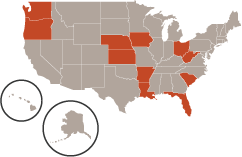MOOC partnership with Stanford benefits English learners
Online course helps teachers aid students in mastering skills required by Common Core
(Read the original article on the Stanford University website.)
Amanda Smith teaches third grade in Nyssa, Oregon, a town of 3,267 people located along the banks of the Snake River, just across the border from Idaho. Most of the parents in her school are involved in the local agricultural industry, growing potatoes, sugar beets, onions and corn. About half the students in her class speak Spanish at home.
It's a long drive from Nyssa to the nearest shopping center, let alone a college campus. But thanks to a free massive open online course, or MOOC, this past fall from Stanford and Oregon State University, Smith was able to connect via computer with thousands of her colleagues across Oregon and other states, as well as some of the world's leading experts on education for English language learners.

First graders in a dual language program work on a poster project in Corvallis, Oregon.
"There are a lot of things done differently throughout the country that teachers in rural areas don't always get a chance to see," said Smith, one of 5,000 educators who registered for the eight-week online course. "For me, the ability to network with people around the country was huge."
Supporting English Language Learners under New Standards was developed by scholars in the Understanding Language Initiative at the Stanford Graduate School of Education, in a first-time partnership with OSU and the Oregon Department of Education. Its aim was to help all K-12 instructors – particularly those teaching English language learners – assist their students in mastering the complex language and reasoning skills required by the new Common Core and English Language Proficiency standards.
Martha Castellon, executive director of the Understanding Language Initiative, notes that while English language learners make up nearly 11 percent of the total U.S. student population, many lack the necessary fluency to do well under the rigorous new curriculum guidelines.
Supporting English Language Learners under New Standards is the third MOOC that Stanford's Understanding Language Initiative has designed to support states and districts struggling with professional development and Common Core implementation. Its first free massive open online course, Constructive Classroom Conversations, was offered three times last year and attracted 18,415 registrants.
Stanford Education Professor Kenji Hakuta, an experimental psycholinguist who spearheaded the initiative, says he's pretty sure these are among the first MOOCs in the country to be aimed specifically at K-12 professional development.
"Usually professional development is a space occupied by for-profit textbook publishers and independent consultants," he explains, "but we're trying to say, 'Look, MOOCs can be helpful tools, too,' in part because they're free. This approach gets the best knowledge out there into the hands of people who otherwise might not be able to afford it."
Lively and listening
A common theme in all three of the Stanford-based MOOCs is the importance of fostering lively student-to-student academic discourse in the classroom, as opposed to passive listening. As Hakuta explains in one of the first course video clips, "We really believe that students learn best by participating with their peers."
His former Stanford doctoral student, Oregon State Professor Karen Thompson, who partnered with him on last fall's MOOC, feels the same way. "Argumentation really is critical thinking," she explains. "We want to help teachers think about strategies to encourage this type of discourse, and to see videos of classrooms where teachers have tried this."
Sara Rutherford-Quach, an instructor in the MOOCs and director of Understanding Language's online initiatives, adds that language is the often-overlooked "invisible curriculum" in a classroom. "Our MOOCs try to help teachers, especially the teachers of English language learners . . . listen more carefully to the language students are producing," she says, "and better facilitate the types of discourse fostered by the new standards."

A teacher kneels down to talk with an English language learner about an essay he is writing.
Timothy Blackburn, a veteran bilingual educator and an education specialist with the Oregon Department of Education, took the first Stanford MOOC a year ago. He then urged his colleagues at the ODE to co-sponsor last fall's MOOC with Oregon State.
"You can't overstate the value of actually looking at practice in these videos," Blackburn says. "During the day, most teachers' classroom doors are closed; it's really hard for them to see their colleagues at work. But when they listen to the kids talking in these MOOCs, they can see how the students use academic language, and what their teachers are doing to elicit that type of language."
Learning together
In several school districts, whole groups of teachers signed up for the online courses and then met regularly in person to go over the assignments. ELL administrator Cindy Bauer says this hybrid approach worked well this past fall for her colleagues in Canby, Oregon, about 20 miles south of Portland.
"One of our seasoned teachers shared that this was the best professional development she has had in 20 years of teaching ELL students," she notes. "It's been a lot of work; I'll say that right up front. But it was nice to have the flexibility of watching the videos at home, and doing the reading at night. And whenever we called or emailed the instructors, someone always has been there to help us."
Veronica Gallardo, director of the Seattle Public School District's Department of English Language Learners and International Programs, says she particularly appreciated the instructors' willingness to modify the course, to align better with current work in her district. (At one point, they even agreed to upload a couple of new video clips, provided by Seattle schools, to reflect the city's diverse population.)
"The interface between the Common Core and our English language learners is a huge concern to me," Gallardo says, "yet there wasn't very much out there about this subject, in terms of professional development. Thank goodness for Kenji and his team at the Stanford Understanding Language Initiative. They really have made these courses enticing to our teachers."
– Theresa Johnston


